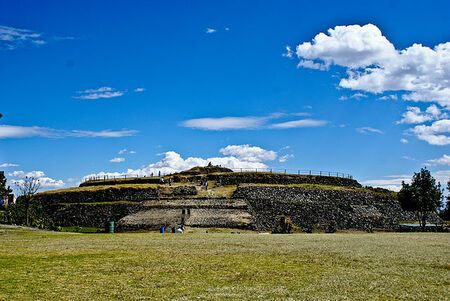The archaeological site of Cuicuilco - cultural wonder in the urban jungle
The archaeological zone of Cuicuilco, where ancient men raised chants and prayers intending to become gods. Get to know more about it.

Submerged in Mexico City, between long avenues such as Periférico Sur and Insurgentes, and flanked by urban complexes such as Villa Olímpica and Centro Inbursa, is the archaeological zone of Cuicuilco, where ancient men raised chants and prayers intending to become gods.
According to research, more than 6,000 years ago, the lakes in the Mexico Basin were smaller and more naturally rich, which led small villages to settle around them. Two thousand years later, between 3,500 and 4,000 B.C., a climatic change caused the level of these aquifers to rise considerably due to constant rainfall.
This event triggered an exodus in search of higher places where people could seek protection. One of these migrant villages was the immediate antecedent of what is known today as the Cuicuilca culture, also known as the culture of the hills.
They decided to settle in the delta of two rivers: the Zacatepetl, today's Periferico Avenue, and the Cuicuilco, today's San Fernando Avenue. This territorial occupation would be accompanied by an element that, sometime later, would become a motif of devotion: the Xitle volcano. Its origin dates back to the year 1200 BC.
The cuicuilcas had their great success in the rigorous observation they made of the environment, and took advantage of the lands near the volcanoes for their mineral wealth, thanks to which they began to develop agriculture.
Their main crops were squash, chili, peas, and corn, a factor, among many others, that allowed them to economically control the southern part of the Basin of Mexico. In addition, the Cuicuilca was a culture dedicated to hunting, fishing, and gathering, far from war and identified with peace.
Few archaeological pieces have been found related to warfare, such as the Atlatl, a kind of spear projected by a base that, in combination with the human arm, could travel great distances and cause serious damage. The Cuicuilcas used it exclusively for hunting animals.
This civilization is recognized for its high knowledge in astronomy and architecture because it was the first great city located in the Mesoamerican central highlands and its constructions are characterized by being monumental of civic-religious type.
At present, eight buildings have been identified, of which the Great Basement is the main one, and it is believed that, in its origin, it could hold up to a thousand people in a ceremonial act. This construction is part of a solar marker according to the investigations that have been carried out from satellite photographs that allow having a total perspective of the upper part.
It is directly related to the Xitle volcano, due to its shape, and is dedicated to the god Huehetéotl, of which representations have been found in the form of incense burners with a kneeling human figure carrying a vessel on his back.
In addition to the base, there is the building called Heizer, due to the name of the researcher who excavated it in 1996; these are accompanied by constructions for residential use and truncated cones, used for the storage of seeds.
The area is also home to a great variety of medicinal plants and flowers characteristic of the area, such as the "mayitos" which, when in bloom, indicate the beginning of the rainy season, and animal species such as the opossum, rattlesnake, rattlesnake, eagle, chameleon, and cacomixtle.
Its site museum, composed of five rooms, expresses both the history of the place and its archaeological richness, with obsidian pieces and beads, as well as burials and offerings. In the museum, it is possible to identify different moments in which interventions were carried out at the site.
In the periphery of the great basement, the old subway museum is located, which consists of a kind of tunnel where photographic exhibitions and archaeological pieces have been carried out, a project that is intended to be retaken in the future.
Currently, different programs are being carried out in the area, such as the endemic flora and fauna program, the rescue of Atlatl, and a permanent forest fire prevention plan, since the area is considered one of the city's natural lungs.
The Cuicuilco archeological site registers close to 5 thousand visitors per month and is considered an opportunity to better understand the origin of other cultures such as Teotihuacan due to the migration of Cuicuilcas to the site.
Its close relationship with the city has made this window to the past a cosmopolitan place since it was the setting for films from the so-called golden age of Mexican cinema, as well as documentaries and urban activities.
Source INAH




